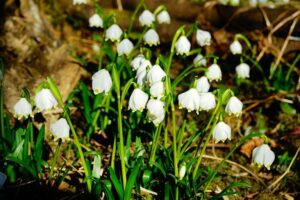This Article on Monocot flower examples illustrates the all-around information about the 20+different monocot flowers, their functions, with examples in detail.
The word “Monocot” refers to mono means one and cot means cotyledon and the word cotyledon means it is one part of the seed that function is to store food materials inside them which are required for the entire growth of an embryo. Now, we can say the monocot flower refers to, the seed of those flowering plants that contain only a single cotyledon
Now take a look at the Nectar flowers and their examples in a detailed way :
- Orchids
- Snowdrops
- Lily
- Tulips
- Iris
- Crocus
- Daffodil
- Bluebell
- White Trillium
- Tuberose
- Yellow Rain Lily
- Amaryllis
- Anthurium
- Canna
- Jonquil
- Freesia
- Agapanthus
- Day Lily
- Lesser Celandine
Orchids
The species of this flower belong to the Orchidaceae family. This flowering plant grows on the branches of other plants rather than rooted in soil, such a type of flowering plant is also known as a perennial plants. The flower of the orchid contains three sepals and petals. The column of the orchid flower contains a waxy tube-like structure, even it also contains a labellum(Extended single lip).At the end of the stem, the leaves of orchids are grown while at the base of the leaves, flowers are grown, that is emerging at the end or from the base of the pseudobulb.
Snowdrops
The species of this flower belong to the Amaryllidaceae family. This monocot flower is around 7 to 12mm in length, having white or green to brown in color. The arrangement of the leaves is to grow at the base of the plant and the position of the ovary is below the attachment of the main point of the sepal or petal.

Snowdrops
Credits: Image by snappygoat.com
Lily
The species of this flower belong to the Liliaceae family. There are different genera are found in the Liliaceae family include: Fritillaria, Tulipa, and Erythronium.The flowers of lilies have different variations in color, shape, numbers, the size of bloom, and the arrangement of flowering parts. The main characteristics of lilies having three petals, sepals, and pistils.The roots are fibrous, leaf veins are parallel and after germination, only a single seed leaf emerges
Tulips
The species of this flower belong to the Liliaceae family. These flowers are a solitary bell-shaped and contain three petals, three sepals, a three-lobed ovary (terminated through a sessile three-lobed stigma), and six stamens. The fruits of tulips are capsulated via many numbers of seeds. Different colors emerge from tulips like purest white, purple to black, yellow, and red to brown. The flowers of tulips have variations in their size, shape, and the time of bloom.

Tulips
Credits: Image by snappygot.com
Iris
The species of this flower belong to the Iridaceae family. The flower of iris contains three broad pollen respective stigma branches in which the anthers are hidden inside the pollen, three sepals, and three petals. This flower has an inferior ovary which contains a total of three carpels in a single pistil, all parts of the flowers are located above the inferior ovary. The ovules are present within the ovary which are converted into seed and after maturation of the seed, they form dry capsule fruits

Iris
Credits: Image by snappygot.com
Crocus
The species of this flower belong to the Iridaceae family and Crocoideae subfamily. The flowers of crocus have different colors relatively yellow, purple, white, or orange. The flower of the crocus contains 3 sepals, 3 petals, and 3 stamens. The tube of the flower is narrow, cylindrical, slender, and long and each flower has a single style. The fruits of these flowers are capsulated and ellipsoid in shape

Crocus
Credits: Image by snappygot.com
Daffodil
The species of this flower belong to the Amaryllidaceae family. The color of flowers is generally yellow and around 25 to 35mm in petal length, the arrangement of leaves is at the base of the plant. The ovary of this flower is present below the main point of sepal or petal attachment. It contains capsulated fruit which releases two or more seeds during a very dry condition.
Bluebell
The species of this flower belong to the Asparagaceae family. The shape of this flower is tubular or bell-shaped, having a color ranging from white and blue or deep purple to pink. The petals of the flowers are strongly curved upwards. Each flower contains six stamens, three outer and inner sepals, and one pistil which contains three fused carpels. Both sepals and petals are identical to each other which known as a Tepals

Bluebell
Credits: Image by snappygot.com
White Trillium
The species of this flower belong to the Melanthiaceae family.The flower contains its parts in a group of three mainly petals, sepals, stamen, and stigma. The flowers are generally purple, pink, yellow, solitary white, or greenish-white in color. These trillium plants contain oval bracts which arise from an underground rhizome, that is functionally similar to the leaves.
Spiderworts
The species of this flower belong to the Commelinaceae family. The flowers of spiderworts are bisexually radially symmetric and the color of flowers is generally various shades of blue or purple, pink, and white.The arrangement of leaves is around the stem in spiral form and it generally lacks leafstalks.
Tuberose
These flowers belong to the species of the Asparagaceae family. This flower is present in fragrant waxy white color at the tip of the stem in the form of a cluster. The flower of tuberose contains sword-shaped six petals and the stem of the flower which grows around 3 feet high.

Tuberose
Credits: Image by snappygot.com
Yellow Rain Lily
These flowers belong to the species of the Amaryllidaceae family. The flower of yellow rain lily is upright, funnel-shaped having a green tube around 3 to 5 cm in length. The color of the flower is lemon yellow, white, or purple.The flower has six yellow petals and blooms over a long stalk, while the stamen are larger. The leaf of this rain lily is slender and slim.
Amaryllis
These flowers belong to the species of the family Amaryllidaceae.The flowers of this plant are symmetrical, bisexual, and linear. The arrangement of six tepals and six stamens in two whorls of three. The leaf shapes of this flower are lanceolate, elliptic, and linear. The fruit of amaryllis present in a fleshy, dry, berry-like capsule shape.
Anthurium
These flowers belong to species of the Araceae family.The leaf of this plant are leathery, variable in shape, heart-shaped, and clustered. The flowers are numerous bisexual and made up of spathe or also known as a white shield-like petal surrounding the inflorescence and the other is a spadix. The combination of spathe and spadix always makes flowers as a Monocot.

Anthurium
Credits: Image by snappygot.com
Canna
These flowers belong to the species of the Cannaceae family. The flowers are asymmetrical and it has two to three petals, labellum, and one half functional stamen. The flowers of canna have a variable color namely yellow, red, or orange.

Canna
Credits: Image by snappygot.com
Jonquil
These flowers belong to the species of the Amaryllidaceae family. It is one type of daffodil flower. The most common name of this flower is a narcissus jonquilla. The flowers have attractive fragrances which are present in a clustered and in short tube form mainly white or yellow in color. The leaves of this plant are long and linear
Freesia
These flowers belong to the species of the Iridaceae family. The flowers of freesia are 2 feet tall and the spike usually turns at the right angle from the stem. The flowers are in different colors blue, white, yellow, and orange.
Agapanthus
These flowers belong to the species of the Amaryllidaceae family. The most common name of this flower is “lily of the Nile” also known as an African lily. The flowers are present in funnel-shaped, clustered form, large, spherical, and typically white, purple, and blue in color.

Agapanthus
Credits: Image by snappygot.com
Day Lily
These flowers belong to the family of Asphodelaceae family. The flowers are usually in bell-shaped funnels having red or yellow in color. The flower of daylily has three sepal and petals, six stamen, and two-lobed anthers. It also contains the throat refers to as the central-most part of the flower. These flowers form capsules after successful pollination.
Lesser celandine
These flowers belong to the family of Ranunculaceae family. The flowers are yellow in color, bright star-shaped, contain around eight to twelve petals, heart-shaped leaves, and buttercup flowers. The main habitat of this flower is woodland and grassland. It is one kind of hairless perennial plant. The leaves are variable in number, shape, and size. It contains numerous carpels and stamen and one single-seeded fruit.

Lesser celandine
Credits: Image by snappygot.com
Also Read:
- Analogous structures examples
- Are protists paraphyletic
- Incomplete flower example
- Moss examples
- Are proteins traits 2
- Is vitamin a coenzyme
- Hypertonic vs hypotonic
- When does cell division occur
- Difference between animal and plant cell chromosomes
- Protein synthesis process

Hello, I am Bhairavi Rathod, I have completed my Master’s in Biotechnology and qualified ICAR NET 2021 in Agricultural Biotechnology. My area of specialization is Integrated Biotechnology. I have the experience to teach and write very complex things in a simple way for learners.